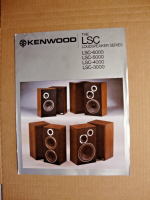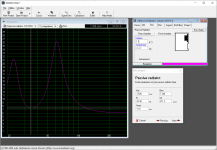I need to replace the passive radiators on an old set of Kenwood LSC-6000's. The foam surrounds on the passives is rotted away. Strangely enough, the drivers are okay. The client would like to keep the sound as close as possible to the original, so I'm on the hunt now for a replacement.
Pertinent info:
Cabinet measures: 12" x 24" x 10.25"
Radiator measures: 212mm across TOTAL.
what else do I need to know? The radiator fits down into a recess, meaning that the 212mm would be nice to hit spot on... although I feel that won't happen.
Pertinent info:
Cabinet measures: 12" x 24" x 10.25"
Radiator measures: 212mm across TOTAL.
what else do I need to know? The radiator fits down into a recess, meaning that the 212mm would be nice to hit spot on... although I feel that won't happen.
Can re foam the passive.
Or likely a modern passive will have more xmax and not distort as quick.
really depends more on the cutout.
The inner cutout on the daytons is small so it could fit into a lot of speakers.
Then the mounting area is relatively generous.
Outer is 214mm and inner is 180mm so likely will fit.
Once you know the tune frequency weight can be added.
Dayton DS-215-PR-8"
Going off posted outer measurements and assuming they used 1/2" wood
the inner cabinet volume is approx 1.3 cubic feet or 37 liters
hard to find pictures think i found one?

Or likely a modern passive will have more xmax and not distort as quick.
really depends more on the cutout.
The inner cutout on the daytons is small so it could fit into a lot of speakers.
Then the mounting area is relatively generous.
Outer is 214mm and inner is 180mm so likely will fit.
Once you know the tune frequency weight can be added.
Dayton DS-215-PR-8"
Going off posted outer measurements and assuming they used 1/2" wood
the inner cabinet volume is approx 1.3 cubic feet or 37 liters
hard to find pictures think i found one?

Last edited:
Well for the most part generic answer , we dont.
Think GM was just quickly getting to all things involved.
changing to after market passive, usually assumed
additional weight is added.
and exactly we don't know tune and it could be
determined by a impedance curve measurement.
but that is impossible, since surround is bad.
the options are re foam the factory passive.
or see where a aftermarket would be.
and if weight needs added.
I ran the after market in sim to the volume of the enclosure
you have.
luckily as assumed a modern aftermarket is gonna be
stiffer and have way more range than factory.
So pretty much no weight needs adding.
The real question is can we get any info on the factory woofer.
I tried couldnt find much.
So assume we have average Qts speaker in 1.3 cubic ft.
So 35 to 42 Hz sounds about right for a 8"
usually a passive would give you a high tuning till weight
is added. this case the aftermarket doesnt need weight
Think GM was just quickly getting to all things involved.
changing to after market passive, usually assumed
additional weight is added.
and exactly we don't know tune and it could be
determined by a impedance curve measurement.
but that is impossible, since surround is bad.
the options are re foam the factory passive.
or see where a aftermarket would be.
and if weight needs added.
I ran the after market in sim to the volume of the enclosure
you have.
luckily as assumed a modern aftermarket is gonna be
stiffer and have way more range than factory.
So pretty much no weight needs adding.
The real question is can we get any info on the factory woofer.
I tried couldnt find much.
So assume we have average Qts speaker in 1.3 cubic ft.
So 35 to 42 Hz sounds about right for a 8"
usually a passive would give you a high tuning till weight
is added. this case the aftermarket doesnt need weight
Not really in that I'm always short on time these days, so could/should have elaborated...... anyway, speakers sometimes have a frequency range on a NP or sticker among other marketing specs, so the bass number is usually close or actual tuning when new; otherwise was hoping there was some marketing pub that either came with the speaker or online somewhere I didn't find quickly in a Google search.Sorry to be an imbecil. how do I know the speakers tuning?
sounds like brochure specs for -3 or -10
I mean actual driver T/S
It is ok , really not out there to be found.
Can only assume resonant frequency is close to that
35 to 45 Hz
and a alignment will put you 3 to 6Hz above or below.
So it is what it is, id be comfortable with 35 Hz
using the Dayton
I mean actual driver T/S
It is ok , really not out there to be found.
Can only assume resonant frequency is close to that
35 to 45 Hz
and a alignment will put you 3 to 6Hz above or below.
So it is what it is, id be comfortable with 35 Hz
using the Dayton
One another note, does anybody know why the outside of the cabinets have a "stickiness" to them? I know there are a million possibilities, but just in case there is some known "off gassing" or something... Like old steering wheel plastic!
Depends on its coatings' solvent base, be it paint, sealer and/or vinyl finish. Try test wiping it off using a 4:1 vinegar/water mix and if it works, then a quick hand buff to see if it shines up without getting sticky again.
Okay, well got the passives installed. had to 3d print a spacer to ride them above the lip, but no biggie...... but a little bit of running sound through and the driver surrounds are coming apart. Should have guessed it, but anyway now I need to find replacements for them! So again, knowing the size of the box is close enough to get a good guess on what specs I should find in the actual driver?
Be just as simple using the matching Dayton Driver
which matches the passive.
So Dayton DC200-8
Got very lucky on volume.
And Dayton designed pre weighted system rather well.
Ironically BB4 alignment for DC200 is 1.3 cubic feet.
And tuned 30 Hz
with passive sometimes needs to go higher.
Ironically we already know that passive
achieves 34 to 35 Hz tuning.
So good to go.
New 8" woofer and no weight needed on
the passive.
Whats next? new tweeter and crossover too.
Well we have baffle size and actual FRD data now
LOL
which matches the passive.
So Dayton DC200-8
Got very lucky on volume.
And Dayton designed pre weighted system rather well.
Ironically BB4 alignment for DC200 is 1.3 cubic feet.
And tuned 30 Hz
with passive sometimes needs to go higher.
Ironically we already know that passive
achieves 34 to 35 Hz tuning.
So good to go.
New 8" woofer and no weight needed on
the passive.
Whats next? new tweeter and crossover too.
Well we have baffle size and actual FRD data now
LOL
- Home
- Loudspeakers
- Multi-Way
- Need help finding passive radiator for Kenwood LSC-6000
